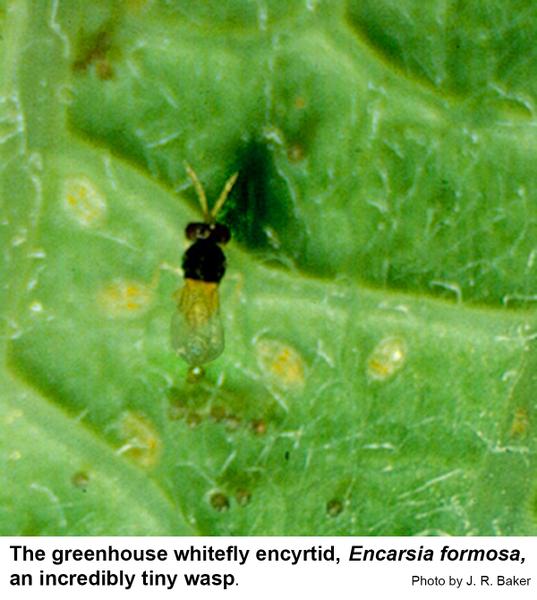General Information
The greenhouse whitefly, Trialeurodes vaporariorum, is 1⁄16 inch long and resembles a tiny, white moth. The almost microscopic, oblong, pale green to purple eggs are inserted into the lower leaf surface, often in a circle or crescent. Nymphs are tiny (up to 1⁄32 inch long), yellow with red eyes, and flat scale-like insects appressed to the lower leaf surface.
Biology
Greenhouse whiteflies are worldwide pests of greenhouse-grown ornamentals and vegetables. First discovered in England in 1856, they were found in the United States in 1870. Tropical Central or South America are suggested origins of the greenhouse whitefly. Greenhouse whiteflies infest a wide variety of ornamental and vegetable crops, and they can survive outdoors during the growing season, particularly in sheltered locations. Even trees may be infested (redbud, Kentucky coffee berry, and avocado). Infested plants become chlorotic and unthrifty. Secondary infections of honeydew and sooty mold further detract from the appearance of the crop. Unless controlled, greenhouse whiteflies may completely destroy the commercial value of a floricultural crop. Greenhouse whiteflies reproduce slowly (a generation every 30 to 45 days), but each female may lay up to 400 eggs and live as long as 2 months. Adults are usually found on the lower surface of new leaves were they insert their eggs. Five to 7 days later, new crawlers hatch and move about the plant for a day or two, often from leaf to leaf. After inserting their mouthparts to feed, they probably do not move again until mature. The crawlers molt into nymphs and then pupae. Finally, a new generation of whitish-yellow adults emerges. They are soon covered by a white, waxy bloom.
Control
It was previously thought that lower greenhouse temperatures used in the culture of some bedding and potted plant varieties tended to encourage infestations because naturally occurring parasitic wasps (Encarsia formosa) are reproductively inhibited at temperatures below 75°F. This does not seem to be the case. Encarsia formosa now in the commercial biological control trade seems to works well at most greenhouse temperatures. Chemical control of whiteflies is difficult because the eggs and immature forms are resistant to many aerosol and insecticide sprays. One must make regular applications of pesticides to control emerging adults until the last of a whole generation of immature whiteflies has emerged.
| Active Ingredient | Trade Name | Labeled Location | Signal Word | IRAC MOA Group | Compatible with Beneficials |
|---|---|---|---|---|---|
| abamectin | Avid | G, N, L | Caution | 6 | Yes |
| acephate | Orthene, Orthenex* | G, N, L | Caution | 1B | No |
| acetamiprid | Tristar | G, N, L | Caution | 4A | Yes |
| bifenthrin | Talstar | G, N, L, I | Caution | 3 | No |
| buprofezin | Talus | G, N | Caution | 16 | Yes |
| dinotefuran | Safari | G, N, L, I | Caution | 4A | Yes |
| flonicamid | Aria | G, N, L | Caution | 9B | Yes |
| horticultural oil | many* | G, N, L, I | Warning | - | Yes |
| imidacloprid | Marathon II | G, N, I | Caution | 4A | Yes |
| imidacloprid | Merit* | N, L, I | Caution | 4A | Yes |
| insecticidal soap | many* | G, N, L, I | Warning | - | Yes |
| kinoprene | Enstar II | G | Caution | 7A | Yes |
| novaluron | Pedestal | G, N | Caution | 5 | Yes |
| pyridaben | Sanmite | G, L, N | Caution | 21A | Yes |
| pyriproxyfen | Distance | G, N, L | Caution | 7C | Yes |
| spirotetramat | Kontos | G, N | Caution | 23 | Yes |
| thiamethoxam | Flagship | G, N | Caution | 4A | Yes |
| G = greenhouse, N= nursery, L = landscape, I = interiorscape * Suitable for homeowner use. When used as directed, pyrethroids are very toxic to insects but are not particularly hazardous to humans and pets (other than fish—avoid using pyrethroids around pools, ponds, and streams). |
|||||
Other Resources
- Managing Whiteflies on Landscape Ornamentals. Eileen A. Buss, E. A., C. Mannion, L. Osborne, and A. Dale. 2017 (revised). University of Florida IFAS Extension.
- Insect and Related Pests of Flowers and Foliage Plants. Baker, J. R. ed. 1994 (revised). North Carolina Cooperative Extension publication AG-136.
- NC State Extension Plant Pathology Publications
- NC State Horticultural Science Publications
- North Carolina Agricultural Chemicals Manual
For assistance with a specific problem, contact your local N.C. Cooperative Extension center.
Publication date: May 1, 2000
Reviewed/Revised: Nov. 21, 2020
Recommendations for the use of agricultural chemicals are included in this publication as a convenience to the reader. The use of brand names and any mention or listing of commercial products or services in this publication does not imply endorsement by NC State University or N.C. A&T State University nor discrimination against similar products or services not mentioned. Individuals who use agricultural chemicals are responsible for ensuring that the intended use complies with current regulations and conforms to the product label. Be sure to obtain current information about usage regulations and examine a current product label before applying any chemical. For assistance, contact your local N.C. Cooperative Extension county center.
N.C. Cooperative Extension prohibits discrimination and harassment regardless of age, color, disability, family and marital status, gender identity, national origin, political beliefs, race, religion, sex (including pregnancy), sexual orientation and veteran status.







